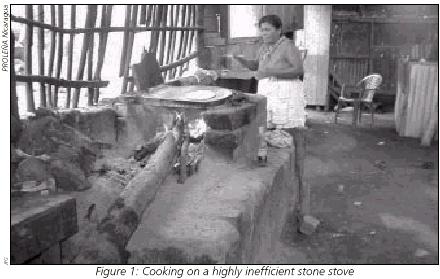The modernization of small business through
the Ecostove
in Nicaragua.
by Rogério C.
de Miranda and Frances G. Tilney, Ecofogones y Reposición
Forestal, PROLEÑA/Nicaragua,
Apartado Postal C-321, Managua, Nicaragua. Fax (505) 249 0116 Email:
rmiranda@sdnnic.org.ni
In urban and rural Nicaragua, most
women spend a great deal of the
day hovering over an open flame.
While smoke billows from
between the three stones of a tra-ditional fire, women stir
corn,
cook beans and scald their hands
on tortillas, meanwhile breathing
in particulate matter and damaging
their health. Their children congre-gate in the under-ventilated
cook-ing
areas, peering through the
haze created by the smoke from
the open flames and playing with
the dusty, gray refuse that collects
on the walls and ceilings of the
home after years of constant
smoke impact. After diarrhea,
acute respiratory illness is the
leading cause of death in young
children in Nicaragua. The culprit
of this health crisis is clearly an
archaic stove design that begs for
modernization and development.
Besides the difficulties associ-ated
with constant smoke inhala-tion
however, a traditional
Nicaraguan stove adds to the eco-nomic difficulties of a family
due
to the inefficiency of its energy
consumption. To heat small
amounts of food, women will
often place tremendously large
pieces of wood or the entire trunk
of a small tree (Figure 1) into one
|
Modernisation de petites entreprises
grâce à l''EcoStove' au
Nicaragua.
Le foyer traditionnel utilisé au Nicaragua est polluant
et non efficace
énergétiquement. Le nouveau foyer
diminue les coûts en combustible, et
réduit de moitié les émissions de fumée qui sont évacuées
par une
cheminée. Les femmes, qui auparavant se plaignaient
de problèmes
respiratoires, de maux de têtes et de pertes d'acuité
visuelle, travaillent
maintenant dans de meilleures conditions. Par ailleurs,
l'EcoStove a permis
aux femmes de générer un modeste revenu provenant
de la préparation et
la vente de repas. |
side of the stone structure from
where much of the wood-burning
energy is dissipated, rather than
being directed at cooking the
food. The demand for cooking
fuel has remained high in
Nicaragua over the past years, as
the unemployment rate has risen
very rapidly, and many women
are forced to support an entire
extended family on the small
income of a cooking enterprise.
To try to earn some income,
women create small businesses by
cooking tortillas, soups and quick
meals. In Nicaragua, the typical
meal of a nacatamale - a mixture
of maize, vegetables and meat
boiled for two hours inside a
wrapping of plantain leaf - is
often the main income-generating
activity for a family. Selling food
products from the backdoor of a
home or from a street-side stand,
|
women add to their daily regime
of cooking family meals and
cleaning the home through this
time-intensive activity, in the
hopes that the small profits will
sustain the family until a husband
or older child might find work.
Younger daughters, and occasionally
sons, will contribute to the
mother's enterprise by shaping tortillas
or feeding the fire-further
increasing their health problems
and adding to the economic bur-den
of buying constant fuel wood.
Within the urban centre of Managua
and in smaller cities outside
the capital, a new variety of stove
is finding a place, among the traditional
three-stone models. The
EcoStove (Figure 2), an efficient
enclosed stove, was first developed
in Honduras under the auspices
of Proleña, an NGO devoted
to sustainable energy development |
|

|
in Latin America, with technical
support from APROVECHO (see
p.36) and financial support from
TREES, WATER and PEOPLE, (both
US based NGO's).
The EcoStove is an innovative
woodstove which basically is a
vented and insulated stove. The
fire is entirely enclosed within the
firebox (a ceramic elbow) which,
in addition, is placed within a box
of insulated material such as
pumice rock. Above the fire there
is a plancha (a large griddle
metal) which is heated firstly by
the flames and secondly by the
hot gases (smoke) being circu-lated
under the plancha, before
|
| Boiling Point No 47 Autumn 2001 |
3 |
Próxima Página>>>
|